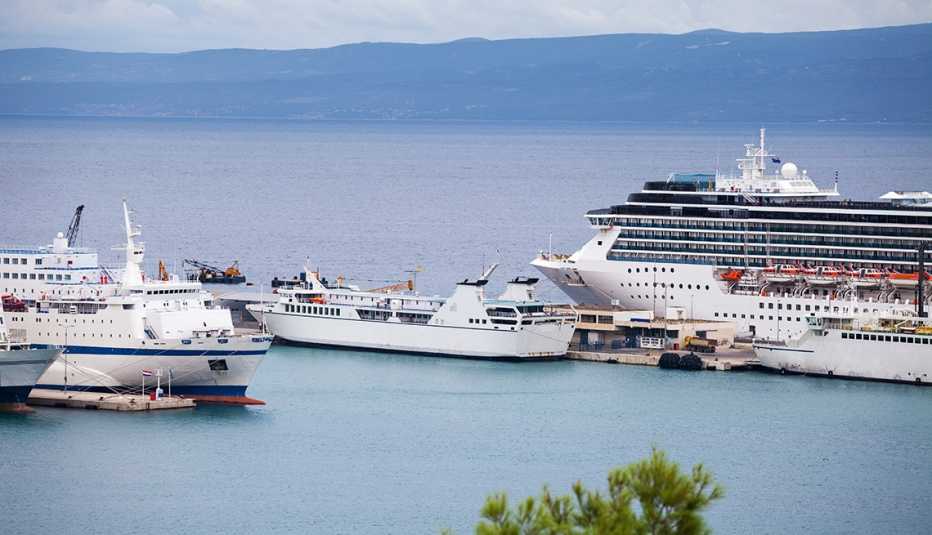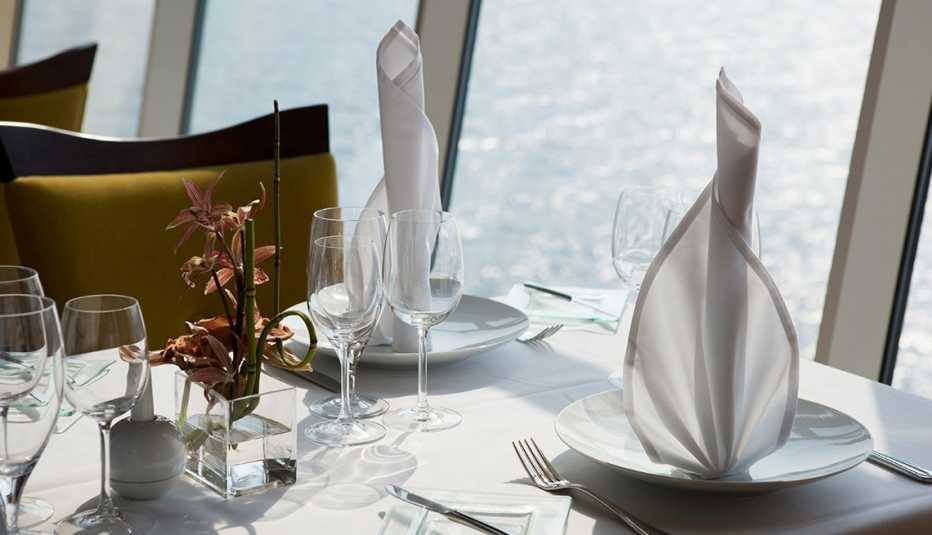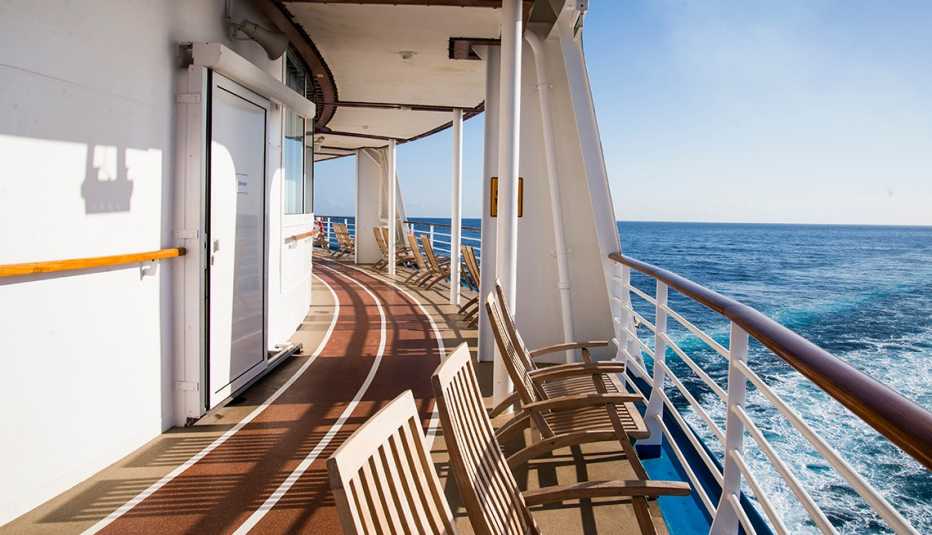AARP Hearing Center


Cruises are one of the fastest-growing tourism sectors. This year, the industry is expected to see some 36 million travelers — up from around 30 million in 2019, according to the Cruise Lines International Association (CLIA). Before you book a cruise — whether it’s your first or 50th boating adventure — check out our smart guide filled with helpful tips, resources and strategies for smooth sailing.


PLANNING YOUR CRUISE
1. Choose the right sized ship for you
Cruise ship sizes run the gamut, from megaships that host thousands of passengers to small ships with a few dozen travelers. According to Mikkel Woodruff, travel writer and founder of the cruise blog Sometimes Sailing, knowing what you want out of a cruise will help you narrow down the right ship size for you. “Know your personality,” Woodruff says. While she and her husband enjoy a simple dinner and drink before bed — ideal for smaller, lower-key ships — those who prefer a bevy of entertainment options, be it numerous restaurants, onboard casinos or live shows, are better off with larger boats. Another ship-size insight to keep in mind: Larger ships are often less expensive, says Woodruff.
2. Open versus closed loops
Beyond ship size, you’ll also want to consider which type of route best fits your travel goals. On a closed-loop cruise, the journey starts and ends in the same place, says Janene Beane, author of TikTok account She Knows Her Ship. “Open loop is where you start in one place and end in a totally different place.” One advantage of a closed-loop cruise that starts and ends in a U.S. port is you likely don’t need a passport, even if your boat is leaving the country, says Beane. (That said, it’s important to confirm this detail with the cruise line.) Those who want to bookend their cruise with mini adventures may be better off with the open-loop route. That way you can vacation in different cities on either side of your cruise.
3. Find advice in online forums
Woodruff says social media sites like Facebook have numerous cruise groups, including some for specific cruise lines or types of cruise travel, such as expedition cruising. You can also seek out sites like cruisecritic.com, cruiseline.com or cruisehive.com. “People are honest with their opinions,” Woodruff says of these third-party groups. You can search through threads to gather intel on specific cruise lines, or post your specific cruise goals or questions to receive tried-and-true advice from other cruise travelers.
4. When to book
Choosing when to book your cruise depends largely on the destination’s popularity and season. “Alaska [cruises are] really hot, and people are often booking [them] a year or two out,” says Woodruff. This need for early booking stems from not only the destination’s popularity, but its limited travel season — just like Antarctica, which is experiencing a cruise boom of its own. Ships can sail to these far north and south locales only in the warmer months, such as November to February for Antarctica or May to September for Alaska. This short season limits availability. Meanwhile, options abound in year-round escapes like the Caribbean, Woodruff says.
5. Find a cabin with a view
When it comes to getting the most scenic cabin, Woodruff has a rule of thumb: “The higher the deck, the better the view.” The back of the ship offers the best vantage point because the balconies tend to be slightly larger, Woodruff notes. These in-demand rooms typically sell out quickly, so book as early as you can. On some ships, the lower decks only have a porthole with no balcony, she says.
6. Try a solo cruise
According to CLIA, solo travel is growing in popularity. Companies are also making the travel style more feasible by retrofitting ships with additional single cabins. (Historically, booking a solo cruise comes with a single supplement surcharge; many still require this, but the industry is changing.) Beane, who was initially nervous about cruising alone, now enjoys these solo voyages. “You meet new people, or you can just be by yourself and do what you want,” she says. “There’s always somebody to take care of you. There’s so much [in terms of logistics that cruisers] don’t have to worry about.” Read our Smart Guide to Solo Travel for more tips.
7. Consider niche-interest cruises
If you have a special interest — say, birding or classical music — there’s likely a niche cruise for you, says Chris Gray Faust, executive editor of the review site Cruise Critic. “Some of the more well-known [niche cruises] are around music,” says Faust. The options are about as diverse as your cruise’s travel destinations. Themed cruises include a focus on songwriters from the ’60s or ’70s, upcoming Royal Caribbean Taylor Swift–themed sailings in 2024, a specific food- and wine-themed trip, or even Christmas market cruises for cozying up with some holiday cheer.
8. Choosing a cruise destination
Most destinations offer at least some sort of cruise option, whether it’s sailing by ocean, navigating rivers or even crossing massive lakes. According to CLIA, the Caribbean was the top cruise destination for 2022, but other popular options include the Mediterranean, Northern Europe, Alaska, China, Australia and New Zealand. The Great Lakes region in the Midwest has also recently expanded its cruise offerings, while far-flung escapes, such as the Arctic or Antarctica, increasingly attract intrepid cruisers.
9. Book a multigenerational cruise
With a variety of onboard activities and land-based excursions, cruises offer something for nearly all types of travelers. This customization makes cruising perfect for multigenerational family trips, says Faust. “You can do different excursions or different things around the ship, then gather at dinnertime,” she says. Varying budget options, especially when it comes to cabins, ensure everyone can join too. “What we often see is that the retiree may have the suite, their family might have a family cabin, and those just out of college have an inside cabin,” she says. “There are different price points for different budgets.”
10. Crave adventure? Try an expedition
An expedition cruise centers on exploration and adventure. The ships are often smaller, giving travelers the chance to more deeply experience a destination. This is particularly important in places like Antarctica, where international law means strict regulations. According to the International Association of Antarctica Tour Operators, for boats with more than 500 passengers, guests are not allowed to actually land or walk on the continent itself. “A ship of 200 people can get up close and personal,” says Faust. On these boats, the guides will take groups of guests to walk, hike or even camp on the White Continent. In addition to access, expedition ships ensure you travel alongside experts. “They have an expedition staff that’s with you to help you interpret the nature and wildlife,” says Faust. Companies that are known for expedition cruising — particularly to Earth’s farthest-flung regions — include Viking Cruises, Hurtigruten and Lindblad Expeditions.
11. Sail longer
If you want to see it all — and your time allows it — enjoy another cruising trend: longer-term sailings. Cruise lines are pushing the boundaries of trip durations, from Celebrity Cruises’ 52-night trip from Rome to New Zealand to Viking’s Grand Journeys, which span multiple weeks or even months, or Seabourn’s five-month, 72-port itineraries. “What a great way to retire,” says Faust. These extended cruises usually depart in the beginning of the year and sail for a few months or longer — a perfect recipe for those hoping to escape the cold back home, she says. “They are expensive, but a long list of things come with them, and it really forms this community at sea.”
12. How to plan post-trip extensions
Some cruise lines offer post-trip extensions to help travelers make the most of their vacations. While these offerings do make planning more streamlined, with set itineraries and logistics like transportation coordinated, it’s important to read the fine print to understand what’s included, what’s not, and if you could get a better deal on your own or with a travel agent. “Some [post-trip extensions] can be great for the convenience,” Faust says, noting you often won’t have to worry about toting your bag or coordinating transportation. “But really think about what you want after a trip. Do you still want to be in a group environment or do you want more free time?”
13. Turn to a travel agent
If choosing the right cruise stresses you out, or you’re worried about booking the best room and onboard experiences, work with a travel agent. “Travel advisers are consumer advocates whose primary responsibility is matching their client with the right cruise that will meet or exceed their expectations,” says Charles Sylvia, vice president of trade relations for CLIA. A travel adviser will help you navigate the cruise selection process, and sort out any pre- or mid-trip problems. The best perk? They’re free to passengers. “Their commission is automatically built into cruise fares regardless of whether you work with one or not, costing you no additional money,” says Sylvia.
14. Invest in travel insurance
In cruising, like any travel, it’s better to be safe than sorry — and few investments offer more peace of mind than travel insurance. When Beane’s parents had to cancel their cruise due to an unexpected surgery, they were able to get a full refund thanks to their travel insurance policy. Additionally, insurance will ensure you get the right care if there’s an accident or you get sick while on the trip. Companies that offer cruise-specific insurance include World Nomads, Allianz Travel and Travel Guard. Note: Insurance policies vary and not all offer a full refund. Make sure you read all the fine print.


GET A DEAL
15. Save with “wave season”
One of the best ways to grab a great cruise deal is to book during “wave season,” a promotional period that takes place roughly from December through March. “It’s when cruise lines do big pushes to get sales up,” Woodruff says. “A lot of them have deals, whether it’s for free Wi-Fi or free airfare.” In some cases, the lines offer lower-cost cruise deposits, and you can also grab major discounts on some fares.




































































More AARP Smart Guides
AARP Members Only Access
Enjoy special content just for AARP members, including full-length films and books, AARP Smart Guides, celebrity Q&As, quizzes, tutorials and classesPlan a Low-Drama Big Group Vacation
Whether it’s a generational family trip or a friends getaway, here’s how to plan a stress-free escape
AARP Smart Guide to International Travel
Everything you need to plan your trip abroad
Travel With Confidence — Alone
AARP Smart Guide to Solo Travel shares 23 tips on making a successful trip by yourself
Recommended for You